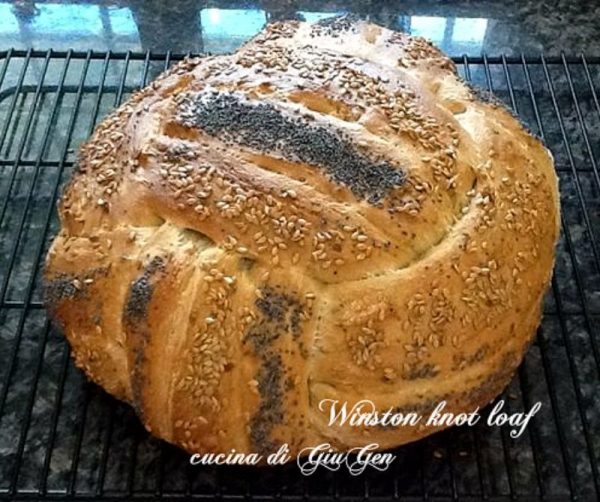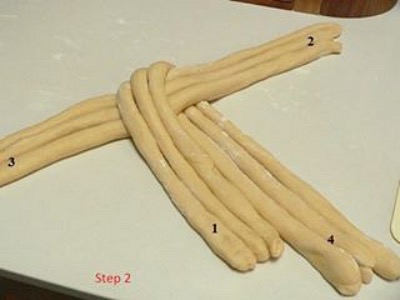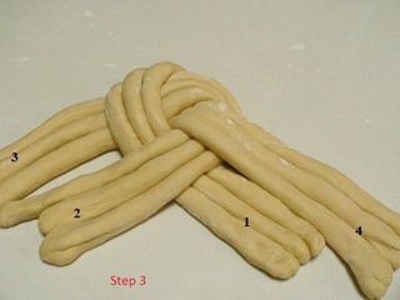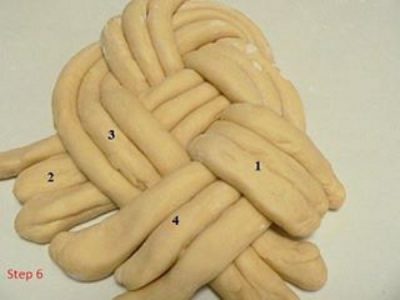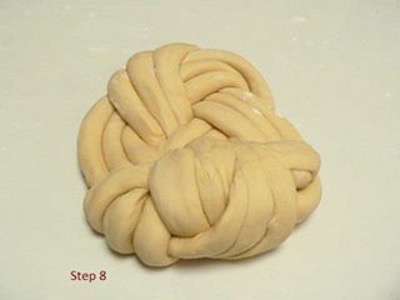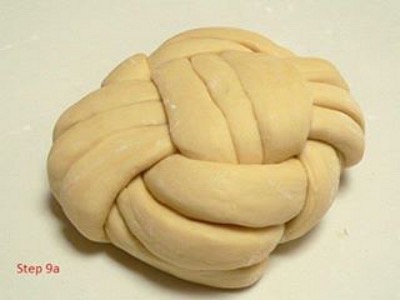Ingredienti per la pagnotta nodo di Winston
- 1000 gr di farina 1 con germe di grano e semi di girasole;
- 300 gr di lievito madre,
- oppure 10 gr di lievito di birra fresco
- 540 gr di acqua,
- 1 uovo
- 15 gr (1 cucchiaio) di olio extra vergine d’oliva
- 10 gr (1 cucchiao) di malto o miele di acacia,
- 20 gr (2 cucchiaini) di sale
Per spennellare
- 1 tuorlo d’uovo
- 1 cucchiao di latte
- semi di lino
- semi di papavero
Dopo aver impastato tutto lasciare lievitare fino a radoppio del suo volum. Per dare forma seguite le istruzione in basso.
Ciascuno dei pagnotti è stata fatta con un lotto completo della ricetta intrecciato pasta di pane – circa 960g ciascuna. L’impasto è stato diviso in sei palline di circa 160g ciascuna, e poi rotolati in filoncini lunghi 60 cm circa. Spolverare leggermente con un poco di farina per migliorare la definizione della pagnotta finita.
Le foto dettagliate sei passi (con scritto step) sono state prese dal questo link: http://figjamandlimecordial.com/2010/09/24/winsto
- Passo 1: Collocare la pasta come illustrato di seguito. Da ora in poi, ciascun gruppo di tre filoncinii adiacenti sarà trattata come una singola unità. Si noti che quando ciascun gruppo è tessuta, i filoncini i non devono essere ribaltati, ma semplicemente ruotati, in modo che la parte superiore `e rivolta verso l’alto per l’intero processo.
- Passo 2: Ruotare gruppo 1 fino ad accostrarsi al gruppo 4.
- Passo 3: Ruotare, senza girare, gruppo 2 sotto il gruppo di 4 e sopra gruppo 1. Dovrebbe finire accanto al gruppo 3.
- Passo 4: Rotare gruppo 3 sopra l gruppo 2 e accostare accanto al gruppo 1.
- Passo 5 : Intrecciare gruppo 4 sotto gruppo 1 e sopra gruppo 3. Ci siamo quasi!
- Passo 6: Portare quello che rimasto di gruppo 2 sopra gruppo 4, quindischiacciare tutti i pezzi assieme nella parte inferiore. Non preoccupatevi troppo del’accuratezza, in quanto questo finirà sulla parte inferiore della pagnotta.
- Passo 7: Piegare il fondo della pasta (il pezzo che hai appena schiacciato insieme) verso l’alto al centro della pasta.
- Passo 8: Ripete con la parte superiore della pasta. Schiacciare i due pezzi che avete piegati insieme, ma attenzione a non schiacciare la pasta verso il basso, o appiattirà il disegno.
- Passo 9: Ora girare la pagnotta. Mettere l’impasto su un vassoio foderato di carta da forno, quindi coprire con pellicola trasparente oliato e lasciare in un luogo tiepido a lievitare. Preriscaldare il forno statico a 200C (400F)
- Passo 10: Per finire, spennellare la pasta lievitata con un tuorlo d’uovo e1 cucchiao di latte (a piacere spargere con semi di lino, papavero, ecc.)
- Passo 11: Cuocere per circa 40 – 50 minuti, o fino a doratura e suono vuoto. Ridurre il calore verso la fine se inizia a rosolare troppo per i vostri gusti. Togliere dal forno e lasciare raffreddare su una gratella.
Buon divertimento!
Giugen
English Winston's knot loaf contains flour number 1 with wheat germ and sunflower seeds sprinkled with poppy seeds and seeds.
Ingredients for Winston knot loaf
- 1 Kg of flower No. 1 with wheat germ and sunflower seeds
- 300 gr of acid dough
- 540 gr of water
- 1 egg
- 1 tablespoon of extra-virgin olive oil
- 1 tablespoon of honey
- 2 teaspoons of salt
For brushing:
- 1 egg yolk
- 1 tablespoon of milk
- flax seeds
- poppy seeds
After you have mixed all the ingredients allow to proof until double in size. Then follow the instructions below.
Each of the loaves was made with a full batch of approximately 960g each. The dough was divided into six balls of approximately 160g each, and then rolled into long logs.
The photos of the sequence have beetaken from the following link:
http://figjamandlimecordial.com/2010/09/24/winston-knot-tutorial/
- Step 1: Lay the dough out as shown below. From now on, each group of three adjacent logs will be treated as a single unit. Note that when each group is woven, the rolls should not be turned over but simply rotated, so that the part that is face up continues to be face up for the whole process.
- Step 2: Rotate group 1 down to lie adjacent to group 4.
- Step 3: Rotate, without turning over, group 2 under group 4 and over group 1. It should end up next to group 3.
- Step 4: Rotate group 3 over group 2 and lie it next to group 1.
Passo 4: Rotare gruppo 3 sopra l gruppo 2 e accostare accanto al gruppo 1. - Step 5: Weave group 4 under group 1 and over group3.
Passo 5 : Intrecciare gruppo 4 sotto gruppo 1 e sopra gruppo 3. Ci siamo quasi! - Step 6: Bring what you have left of group 2 over group 4, then squelch all the bitstogether at the bottom. Don’t worry too much about neatness, as this ends up onthe underside of the loaf
- Step 7: Fold the bottom of the dough (the bit you’ve just squelched together) upwards to the middle of the dough.
- Step 8: Now repeat with the top of the dough. Squish the two bits you’ve folded in together, but be careful not to squash the dough down, or you’ll flatten out the design.
- Step 9: Now turnthe loaf over. Place the dough on a parchment lined tray, then cover it with oiled cling film and leave it in a warm place to rise. Preheat the oven (static) to 200C (400F).
- Step 10: To finish, brush the risen dough with a 1 egg yolk and a spoon of milk, (if you like you can sprinkle with flax seeds, poppy seeds, or sesame seeds, etc),
- Step 11: Bake for about 40-50 minutes, or until dark brown and hollow sounding. Reduce the heat near the end if it starts to brown too much for your liking. Remove from the oven and allow to cool on a wire rack.
Enjoy
GiuGen


